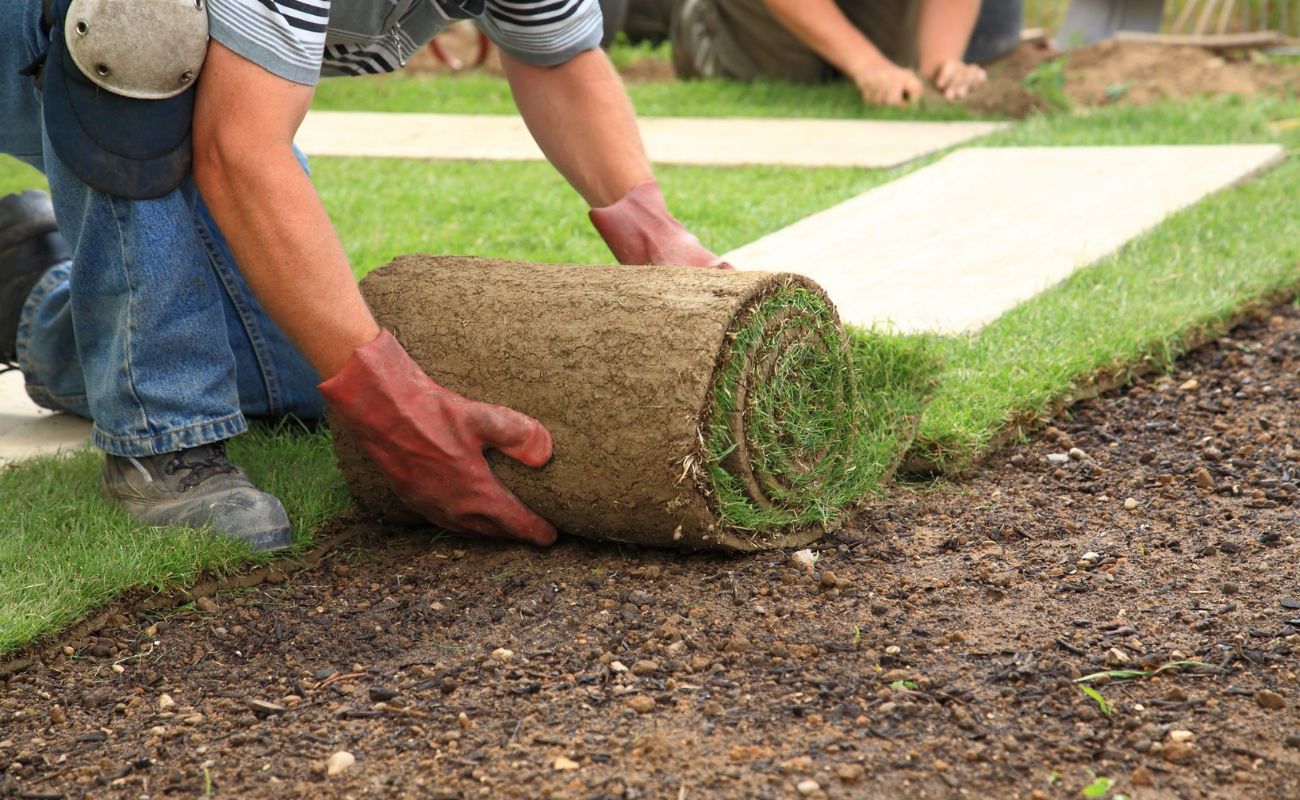Home>Garden Essentials>How To Start A Landscaping Business In Texas


Garden Essentials
How To Start A Landscaping Business In Texas
Modified: March 7, 2024
Learn how to start a successful garden landscaping business in Texas with our comprehensive guide. Get all the tips and tricks you need to grow your business and stand out in the competitive market.
(Many of the links in this article redirect to a specific reviewed product. Your purchase of these products through affiliate links helps to generate commission for Storables.com, at no extra cost. Learn more)
Introduction
Starting a landscaping business in Texas can be a rewarding and lucrative venture. With its vast outdoor spaces and growing population, there is a high demand for landscaping services in the Lone Star State. Whether you have a passion for gardening, love working with plants, or simply enjoy the outdoors, starting your own landscaping business can provide you with the opportunity to turn your hobby into a thriving enterprise.
In this article, we will guide you through the essential steps to start a landscaping business in Texas. From conducting thorough research to obtaining the necessary licenses and permits, we will cover everything you need to know to get your business off the ground.
Before diving into the details, it’s important to note that starting a landscaping business requires more than just having a green thumb. It involves careful planning, strategic decision-making, and a solid understanding of the industry. However, with the right knowledge, resources, and determination, you can establish a successful landscaping business that serves both residential and commercial clients.
So, if you’re ready to embark on this exciting journey, let’s explore the step-by-step process of starting a landscaping business in Texas. From laying the groundwork to providing top-notch services, we will help you navigate through the necessary requirements, challenges, and opportunities that come with running a landscaping business.
In the next section, we will discuss the first step: conducting thorough research and creating a comprehensive business plan. This step is crucial for understanding your target market, identifying competitors, and developing a solid strategy to differentiate your business from others in the industry. So, let’s delve into the details and set a strong foundation for your future landscaping business.
Key Takeaways:
- Starting a landscaping business in Texas involves thorough research, planning, and obtaining the necessary licenses and permits. It’s important to understand the market, differentiate your services, and create a solid business plan.
- Building strong relationships with suppliers, contractors, and clients, along with providing high-quality services, is crucial for the success of a landscaping business in Texas. Adapting to seasonal changes and continuously seeking feedback are also key factors for growth.
Step 1: Research and Plan
The first step towards starting a successful landscaping business in Texas is conducting thorough research and creating a comprehensive business plan. This phase is crucial as it sets the foundation for your business and helps you understand the market, competition, and potential customers.
To begin, research the landscaping industry in Texas, including market trends, customer preferences, and the demand for landscaping services in different regions. This will give you valuable insights into what services are in high demand and how you can position your business to stand out.
Identify your target market, whether it’s residential homeowners, commercial properties, or both. Assess their needs, preferences, and budgets to shape your services accordingly. Understanding your target market will help you tailor your marketing efforts and establish a competitive advantage.
Next, analyze your competition. Identify landscaping businesses in your area and study their services, pricing, and marketing strategies. This will help you identify gaps in the market and find ways to differentiate your business. Look for opportunities to offer unique services or specialize in a specific niche to attract customers who are looking for those specific offerings.
As you conduct your research, consider the seasons and climate in Texas. The state experiences a wide range of weather conditions, which can significantly impact landscaping needs. Familiarize yourself with the plants, flowers, and trees that thrive in different regions of Texas, and incorporate this knowledge into your business plan.
Once you have gathered all the necessary information, it’s time to create a comprehensive business plan. This plan will serve as a roadmap for your landscaping business and provide a clear vision for success. It should outline your business goals, target market, marketing strategies, pricing structure, financial projections, and operational plans.
Your business plan should also include a budget for start-up costs, such as purchasing equipment, obtaining licenses and permits, and marketing expenses. It’s important to have a clear understanding of the financial aspects of your business to ensure its long-term sustainability.
Lastly, seek advice and guidance from industry professionals or mentors who have experience in the landscaping business. Their insights and expertise can provide valuable guidance and help you refine your business plan.
Taking the time to thoroughly research and plan your landscaping business will set a solid foundation for success. It will ensure that you are well-prepared for the challenges and opportunities that lie ahead. With a comprehensive business plan in hand, you can confidently move forward to the next steps of starting your landscaping business in Texas.
Step 2: Determine Business Structure
Once you have conducted thorough research and created a comprehensive business plan, the next step in starting your landscaping business in Texas is to determine the appropriate business structure. The business structure you choose will have legal and tax implications, so it’s essential to understand the different options available.
There are several business structure options to consider, including sole proprietorship, partnership, limited liability company (LLC), and corporation. Each structure has its advantages and disadvantages, so it’s important to evaluate them based on your specific needs, long-term goals, and the level of personal liability you are comfortable with.
1. Sole Proprietorship: This is the simplest form of business structure and involves operating the business as an individual. With this structure, you have complete control over decision-making and all profits go directly to you. However, as a sole proprietor, you are personally liable for any debts or legal obligations of the business.
2. Partnership: If you have a business partner or plan to start the landscaping business with someone else, a partnership structure may be appropriate. In a partnership, the responsibilities, profits, and liabilities are shared between two or more individuals. It’s important to have a legally binding partnership agreement that outlines the roles and responsibilities of each partner.
3. Limited Liability Company (LLC): An LLC offers limited liability protection, meaning that your personal assets are separated from the business’s debts and liabilities. It provides flexibility in management and allows for pass-through taxation. Forming an LLC requires filing the necessary documents with the Texas Secretary of State and paying the associated fees.
4. Corporation: A corporation is a separate legal entity from its owners, known as shareholders. It offers the most significant liability protection, but it also involves more complex legal requirements and formalities. Forming a corporation in Texas requires filing the necessary documents and creating corporate bylaws.
When deciding on the business structure, consider factors such as the level of control you want, the potential for growth, the number of owners involved, and the tax implications. Each structure has its own set of legal and financial considerations, so it may be beneficial to consult with an attorney or accountant specializing in small business matters.
Once you have determined the appropriate business structure, you will need to register your landscaping business with the Texas Secretary of State and obtain the necessary tax identification numbers. This process ensures that your business is recognized by the state and allows you to operate legally.
Taking the time to carefully consider and determine the right business structure is crucial for the long-term success and sustainability of your landscaping business. It ensures that you are operating within the legal framework and provides a solid foundation for future growth and expansion.
Step 3: Register Your Business
Once you have determined the appropriate business structure for your landscaping business in Texas, the next step is to register your business with the necessary government agencies. Registering your business not only establishes its legal presence but also ensures compliance with state regulations and allows you to operate smoothly.
Here are the steps to register your landscaping business in Texas:
1. Choose a Business Name: Select a unique and memorable name for your landscaping business. Ensure that the name is not already in use by another business in Texas. You can search the Texas Secretary of State website or use online directories to check the availability of your chosen business name.
2. Reserve Your Business Name (Optional): If you want to secure your chosen business name before officially registering your business, you can file a Name Reservation Application with the Texas Secretary of State. This reserves the name for 120 days, giving you time to complete the registration process.
3. Register with the Secretary of State: As a legal requirement, you must register your business with the Texas Secretary of State. The exact registration process and forms depend on the business structure you have chosen. Sole proprietors and partnerships may need to file a DBA (“Doing Business As”) if operating under a name other than their own. LLCs and corporations need to file the appropriate formation documents, such as the Certificate of Formation for an LLC or the Articles of Incorporation for a corporation.
4. Obtain an Employer Identification Number (EIN): An EIN is a unique identification number issued by the Internal Revenue Service (IRS) for tax purposes. It is required if you plan to hire employees, open a business bank account, or file certain tax forms. You can apply for an EIN online through the IRS website.
5. Register for State Taxes: In Texas, businesses are subject to various state taxes, including sales tax, franchise tax, and employment taxes if you have employees. You need to register with the Texas Comptroller’s Office to obtain the appropriate tax permits and fulfill your tax obligations.
6. Obtain Required Local Permits and Licenses: Depending on your location and the specific services you provide, you may need to obtain additional permits or licenses at the local level. Check with your city or county government to determine if any additional licenses or permits are required.
7. Consider Trade and Professional Associations: Joining trade and professional associations in the landscaping industry can provide networking opportunities, access to resources, and industry insights. Consider becoming a member of organizations such as the Texas Nursery and Landscape Association (TNLA) or the Associated Landscape Contractors of America (ALCA).
By completing these steps and registering your business, you ensure compliance with legal requirements, establish credibility, and position your landscaping business for success in Texas. Take the time to understand and fulfill all registration obligations to operate your business legally and professionally.
Step 4: Obtain Required Licenses and Permits
Operating a landscaping business in Texas requires obtaining the necessary licenses and permits to ensure compliance with state and local regulations. These licenses and permits not only demonstrate your professionalism and commitment to quality but also protect you from potential legal issues. Here are the key licenses and permits you need to obtain:
1. Landscape Contractor License: In Texas, a landscape contractor license is required for individuals or businesses that provide landscape construction services, including installation of hardscapes, irrigation systems, and other landscaping features. To obtain this license, you must meet certain experience and educational requirements, pass an examination, and pay the required fees.
2. Irrigation License: If your landscaping services include irrigation system installation or maintenance, you will need an irrigation license. This license ensures that you comply with the regulations governing water conservation and irrigation practices in Texas. The Texas Commission on Environmental Quality (TCEQ) is responsible for issuing irrigation licenses.
3. Pesticide Applicator License: If you provide pest control services as part of your landscaping business, you will need a pesticide applicator license. This license is issued by the Texas Department of Agriculture (TDA) and ensures that you are trained and qualified to apply pesticides safely and effectively.
4. Business License and Tax Permits: Depending on your location and the specific requirements of your city or county, you may need a general business license to operate your landscaping business. Additionally, you may need to obtain tax permits, such as a sales tax permit from the Texas Comptroller’s Office, if you sell tangible goods or provide taxable services.
5. Contractor’s License Bond and Liability Insurance: Some cities or counties in Texas may require contractors, including landscape contractors, to obtain a contractor’s license bond. This bond provides financial protection to clients in case of non-compliance or unfinished work. Additionally, it is essential to have liability insurance to protect your business from potential claims or damages that may occur during landscaping operations.
6. Local Permits: Depending on your location, you may need to obtain additional permits from your city or county government. These permits may include zoning permits, signage permits, or permits to operate commercial vehicles or equipment. Check with the local authorities to determine the specific permits required.
It’s crucial to research and understand the licensing and permitting requirements specific to your location in Texas. Each city or county may have its own set of regulations. Failing to obtain the necessary licenses and permits can result in fines, penalties, or the suspension of your business operations.
Remember to keep your licenses and permits up to date and ensure that your employees, if any, also comply with the necessary licensing requirements. By obtaining the required licenses and permits, you not only demonstrate your professionalism but also gain the trust of your clients and protect your business from potential legal complications.
Read more: How To Start Your Landscape Design Business
Step 5: Secure Insurance Coverage
Securing insurance coverage is a critical step in protecting your landscaping business in Texas. Accidents can happen, and having the right insurance policies in place can give you peace of mind and financial protection. Here are some essential insurance coverages to consider:
1. General Liability Insurance: General liability insurance is essential for any landscaping business. It provides coverage for third-party bodily injury, property damage, and personal injury claims that may arise from your business operations. This insurance helps protect you from potential lawsuits and covers legal fees, settlements, or damages awarded against your business.
2. Commercial Property Insurance: Commercial property insurance protects your business property, including tools, equipment, office space, and landscaping supplies, against theft, vandalism, fire, or other covered perils. It is important to accurately assess the value of your business property and choose coverage that adequately protects your assets.
3. Workers’ Compensation Insurance: If you have employees, workers’ compensation insurance is required in Texas. This coverage provides benefits to employees who suffer work-related injuries or illnesses, covering medical expenses, lost wages, rehabilitation, and disability benefits. Workers’ compensation protects both the employee and your business from potential financial burdens.
4. Commercial Auto Insurance: If your landscaping business operates company-owned vehicles or uses vehicles for work-related purposes, commercial auto insurance is necessary. It provides coverage for auto accidents, property damage, and bodily injury caused by your business vehicles. Make sure to adequately insure your vehicles and include comprehensive and collision coverage to protect against accidents, theft, and other risks.
5. Professional Liability Insurance: Also known as errors and omissions insurance, professional liability insurance provides coverage for claims related to professional mistakes or negligence. This coverage is especially important if your landscaping business provides design services or advice to clients. It helps cover legal expenses and damages resulting from errors, omissions, or professional negligence claims.
6. Employment Practices Liability Insurance (EPLI): EPLI coverage protects your business against employee claims related to wrongful termination, discrimination, harassment, or other employment-related issues. This insurance can help cover legal fees, settlements, or judgments resulting from such claims.
It is essential to work with a reputable insurance provider who understands the unique risks and needs of the landscaping industry. They can help assess your specific requirements and tailor insurance coverage to adequately protect your business.
Remember to regularly review your insurance policies and update coverage as your business grows or circumstances change. Having the right insurance coverage in place ensures that your landscaping business is protected from unexpected events and potential financial losses that could otherwise jeopardize your operations.
By securing the necessary insurance coverage, you demonstrate your commitment to professionalism, client satisfaction, and the long-term success of your landscaping business in Texas.
Before starting a landscaping business in Texas, make sure to obtain the necessary licenses and permits required by the state and local authorities. This will ensure that you are operating legally and avoid any potential fines or penalties.
Step 6: Purchase or Lease Equipment and Supplies
To operate a successful landscaping business in Texas, you will need the right equipment and supplies. Whether you choose to purchase or lease, having the necessary tools will enable you to provide efficient and high-quality services to your clients. Here are some key considerations for acquiring equipment and supplies:
1. Assess Your Needs: Start by assessing the specific needs of your landscaping business. Consider the type of services you will offer, the size of the projects you will handle, and the terrain you will be working on. This will help you identify the essential equipment and supplies required to meet your clients’ expectations.
2. Create a Budget: Establish a budget for equipment and supplies that aligns with your business plan and financial projections. Consider the costs of purchasing or leasing equipment, maintenance, fuel, and replacement parts. A well-defined budget will guide your purchasing decisions and help you stay within your financial means.
3. Research Equipment Options: Research different brands and models of equipment to find the ones that best suit your needs and budget. Read reviews, consult industry experts, and compare prices from reputable suppliers. Consider factors such as reliability, durability, and the availability of replacement parts and service.
4. Purchase vs. Lease: Determine whether it makes more sense for your business to purchase or lease equipment. Purchasing equipment gives you long-term ownership and control, but it requires a significant upfront investment. Leasing allows you to access the latest equipment without a large upfront cost, but you don’t own the equipment and may have restrictions on usage.
5. Consider Financing Options: If purchasing equipment is the preferred option, explore financing options such as loans or equipment leasing programs. Many financial institutions offer specialized financing for small businesses, including those in the landscaping industry. Consult with a financial advisor or seek assistance from Small Business Administration (SBA) resources to explore available financing opportunities.
6. Maintain and Insure Equipment: Proper maintenance and regular servicing of your equipment is essential to ensure its longevity and reliable performance. Create a maintenance schedule and follow manufacturer guidelines. Additionally, consider obtaining equipment insurance to protect your investment against theft, damage, or other unforeseen events.
7. Source Reliable Suppliers: Identify reputable suppliers for your landscaping supplies, such as plants, fertilizers, pesticides, and tools. Build relationships with local nurseries, garden centers, and suppliers in the area. Look for suppliers that provide quality products, competitive pricing, and reliable delivery services.
8. Consider Sustainability: As a landscaping business, incorporating sustainable practices can set you apart from the competition and align with the increasing demand for eco-friendly services. Consider investing in electric or battery-powered equipment to reduce noise pollution and emissions. Choose environmentally friendly products, organic fertilizers, and natural pest control methods.
Remember to regularly assess your equipment and supplies needs as your business grows and evolves. Upgrade or replace equipment as necessary to maintain efficiency and meet changing client demands.
By investing in the right equipment and supplies, you position your landscaping business for success in Texas. Quality equipment, proper maintenance, and reliable suppliers will enable you to deliver exceptional services and build a strong reputation in the industry.
Step 7: Create a Marketing Strategy
Creating an effective marketing strategy is crucial for the success and growth of your landscaping business in Texas. A well-executed marketing plan will help you attract new clients, build brand awareness, and differentiate your business in a competitive market. Here are some key steps to creating a successful marketing strategy:
1. Define Your Target Market: Identify your target market by considering factors such as demographics, location, income level, and preferences of potential clients. This will allow you to tailor your marketing efforts to reach the right audience.
2. Develop a Strong Brand Identity: Create a compelling brand that reflects the values and unique selling points of your landscaping business. Design a professional logo, choose a consistent color scheme, and develop a consistent brand voice across all marketing materials.
3. Build a Professional Website: A well-designed and informative website is essential for establishing credibility and attracting potential clients. Include details about your services, portfolio of past projects, testimonials, and contact information. Optimize your website for search engines to increase your online visibility.
4. Utilize Search Engine Optimization (SEO): Implement SEO strategies to improve your website’s visibility in search engine results. Research relevant keywords and incorporate them naturally into your website content. Create valuable, keyword-rich blog posts and optimize meta tags and descriptions.
5. Leverage Social Media: Utilize popular social media platforms such as Facebook, Instagram, and LinkedIn to showcase your work, engage with potential clients, and build brand awareness. Share high-quality images and videos of your projects, share tips and advice, and encourage clients to leave reviews.
6. Implement Content Marketing: Create informative and engaging content such as blog posts, articles, and videos that provide value to your target audience. Share this content on your website and social media platforms to establish your expertise and attract potential clients.
7. Network and Collaborate: Join local business associations, attend industry events, and network with other professionals in the landscaping industry. Collaborate with complementary businesses, such as garden centers or nurseries, to cross-promote each other’s services.
8. Encourage Reviews and Referrals: Satisfied clients can be a powerful marketing tool. Encourage clients to leave reviews on platforms like Google My Business, Yelp, or Angie’s List. Offer referral incentives to existing clients who refer new customers to your business.
9. Invest in Local Advertising: Consider local advertising channels such as newspapers, radio, or local directories to reach potential clients in your area. Sponsor local events or community initiatives to generate goodwill and increase brand visibility.
10. Track and Analyze Results: Regularly monitor and analyze the effectiveness of your marketing efforts. Track website traffic, social media metrics, and lead generation to identify areas of improvement and make data-driven decisions to refine your marketing strategy.
Remember, consistency is key in marketing. Regularly maintain and update your online presence, engage with your audience, and adapt your strategies based on feedback and market trends.
By creating a comprehensive marketing strategy and implementing targeted tactics, you can effectively promote your landscaping business in Texas and attract a steady stream of clients.
Step 8: Build a Network of Suppliers and Contractors
Building a reliable network of suppliers and contractors is essential for the smooth operation of your landscaping business in Texas. Having trusted partners who can provide quality materials, equipment, and additional expertise will help you deliver exceptional results to your clients. Here are some key steps to build a strong network:
1. Identify Your Needs: Determine the specific needs of your landscaping business in terms of materials, plants, tools, and equipment. Consider the volume and frequency of supplies you require, as well as any specialized items that may be necessary for specific projects.
2. Research Suppliers: Research and identify suppliers who offer the products and materials you need. Look for suppliers that provide high-quality goods, competitive pricing, and reliable delivery services. Consider factors such as proximity to your location, availability of bulk discounts, and their reputation in the industry.
3. Establish Relationships: Reach out to potential suppliers and establish relationships based on trust and mutual benefit. Attend trade shows, industry events, and supplier showcases to meet and connect with suppliers in person. Discuss your business needs, negotiate pricing and terms, and ensure that they can meet your specific requirements.
4. Request Samples or Testimonials: Request samples of materials or products from potential suppliers to assess their quality and suitability for your projects. Ask for client testimonials or references to gain insights into the supplier’s reliability and customer service.
5. Maintain Open Communication: Regularly communicate with your suppliers to stay informed about new products, pricing changes, or any potential disruptions to the supply chain. Provide clear instructions and specifications for your orders to ensure accurate delivery.
6. Evaluate Performance: Continuously evaluate the performance of your suppliers to ensure they meet your quality standards, delivery timelines, and pricing expectations. Regularly assess their reliability, responsiveness, and willingness to address any issues that may arise.
7. Seek Recommendations for Contractors: Identify reliable contractors who specialize in areas such as irrigation, hardscaping, or tree services. Seek recommendations from industry professionals, colleagues, or trade associations. Evaluate their experience, expertise, and track record before forming partnerships.
8. Establish Clear Contracts: When working with contractors, establish clear contracts that outline the scope of work, timelines, payment terms, and any other relevant details. Make sure both parties have a comprehensive understanding of the expectations and obligations.
9. Cultivate Professionalism and Trust: Nurture professional relationships with your suppliers and contractors by maintaining open lines of communication, honoring payment terms, and providing feedback on performance. Cultivating a sense of trust and professionalism will help build long-lasting partnerships.
10. Foster Collaboration: Encourage collaboration and open dialogue among your network of suppliers and contractors. This can lead to innovative solutions, cost savings, and better project outcomes. Foster a spirit of teamwork and mutual support.
By building a network of reliable suppliers and contractors, you can ensure a steady supply of high-quality materials and services for your landscaping business in Texas. These partnerships will contribute to the success, efficiency, and professionalism of your operations, ultimately benefiting both your business and your clients.
Step 9: Hire and Train Employees
As your landscaping business in Texas grows, you may need to hire and train employees to help you meet the demands of your clients and expand your services. Hiring and training the right team members is essential to maintain the quality and efficiency of your operations. Here are some key steps to consider:
1. Determine Your Staffing Needs: Assess your current workload and future business projections to determine the number and types of employees you need. Consider whether you require full-time or part-time employees, seasonal workers, or specialist roles such as hardscape installers or irrigation technicians.
2. Create Job Descriptions: Develop clear and detailed job descriptions that outline the responsibilities, skills, and qualifications required for each position. Clearly define the expectations and requirements to attract the right candidates.
3. Source Candidates: Advertise job openings through various channels such as online job boards, industry-specific websites, social media, and local community boards. Consider networking with local trade schools, colleges, or industry associations to find potential candidates with relevant training or experience.
4. Review Applications and Conduct Interviews: Review resumes and applications to shortlist candidates who meet the initial qualifications. Conduct detailed interviews to assess their experience, skills, and cultural fit within your landscaping business. Ask behavioral and situational questions to gauge their problem-solving abilities and work ethic.
5. Check References and Backgrounds: Before making a final hiring decision, contact the references provided by the candidates to verify their work history, skills, and character. Conduct background checks if necessary, especially if the position involves handling sensitive client information or working on clients’ properties.
6. Provide Clear Training and Onboarding: Once you have selected and hired employees, create a comprehensive training program to ensure they understand your company’s procedures, safety protocols, and quality standards. Provide clear instructions on equipment usage, health and safety guidelines, and customer service expectations. Assign mentors or experienced employees to guide and support new hires during their initial period.
7. Encourage Continuing Education and Professional Development: Promote a culture of learning and growth within your landscaping business. Encourage employees to attend industry seminars, conferences, and training programs to expand their skills and knowledge. This will not only benefit individual employees but also contribute to the overall expertise and reputation of your business.
8. Foster a Positive Work Environment: Create a positive work environment where employees feel valued, heard, and motivated. Recognize and reward their hard work and achievements. Encourage open communication, teamwork, and a shared commitment to exceptional service.
9. Provide Ongoing Feedback and Performance Reviews: Regularly provide constructive feedback to employees to help them improve and grow in their roles. Conduct periodic performance reviews to formally assess their progress, set goals, and provide guidance for their professional development.
10. Retain and Engage Employees: Implement strategies to retain top talent, such as offering competitive compensation and benefits packages, providing opportunities for career advancement, and fostering a positive company culture. Recognize and reward employees for their achievements and provide opportunities for personal and professional growth.
By hiring and training skilled and dedicated employees, you can strengthen and expand your landscaping business in Texas. A motivated and well-trained team will help you deliver exceptional services, maintain customer satisfaction, and contribute to the long-term success of your business.
Step 10: Start Providing Services
After completing the necessary preparations and steps to establish your landscaping business in Texas, it’s time to start providing your services to clients. This final step involves executing your business plan, delivering high-quality work, and ensuring customer satisfaction. Here are some key considerations as you begin providing services:
1. Schedule and Project Management: Develop a system for scheduling and managing your projects effectively. Prioritize tasks, allocate resources, and create a timeline to ensure projects are completed on time and within budget. Maintain open communication with clients to manage their expectations and provide regular updates on progress.
2. Safety and Work Regulations: Comply with all safety regulations and guidelines to ensure the well-being of your team, clients, and the environment. Implement safety protocols, provide the necessary personal protective equipment, and train employees on safe work practices. Adhere to applicable laws and regulations related to environmental protection, waste disposal, and noise restrictions.
3. Quality and Attention to Detail: Focus on delivering high-quality workmanship with attention to detail. Ensure that your team is well-trained and equipped with the necessary tools and resources to produce exceptional results. Regularly inspect completed projects to ensure they meet or exceed client expectations.
4. Communicate with Clients: Maintain open and clear communication with your clients throughout the project. Seek their input, address any concerns promptly, and provide updates on progress. Regularly check in with clients after completion to ensure their satisfaction and address any additional needs or follow-up services.
5. Customer Service Excellence: Exceed client expectations by delivering outstanding customer service. Be responsive to client inquiries, provide timely and accurate estimates, and go the extra mile to ensure client satisfaction. Encourage positive reviews and referrals by consistently delivering exceptional service.
6. Adapt to Seasonal Changes: Texas experiences a range of weather conditions throughout the year. Be prepared to adapt your services based on seasonal changes and the specific needs of your clients. Offer services such as landscape maintenance, irrigation management, or winterization strategies to address the varying demands of each season.
7. Seek Feedback and Learn: Continuously seek feedback from clients to improve your services. Actively listen to their suggestions, concerns, and preferences. Use this feedback to refine your processes, address any areas of improvement, and enhance the overall client experience.
8. Ongoing Marketing and Business Development: Even after you start providing services, continue to actively market your business and seek opportunities for growth. Engage in local community events, collaborate with other industry professionals, and leverage online marketing platforms to reach new clients and expand your network.
9. Monitor Financial Performance: Keep a close eye on your business’s financial performance. Regularly review your budget, expenses, and revenue to ensure profitability. Seek professional advice from accountants or financial advisors to optimize your financial management and make informed decisions for your business’s growth.
10. Adapt and Evolve: The landscaping industry is constantly evolving, with new trends, technologies, and client preferences emerging. Stay informed about industry developments, invest in ongoing education and training, and adapt your services to meet the changing needs of your clients and the market.
By starting to provide your landscaping services with a focus on quality, customer satisfaction, and continuous improvement, you set a strong foundation for the long-term success of your business in Texas. Remember to consistently deliver exceptional work, maintain open communication, and nurture your client relationships to foster a positive reputation in the industry.
Conclusion
Starting a landscaping business in Texas is an exciting journey that offers the opportunity for creativity, entrepreneurship, and the enjoyment of the great outdoors. By following the steps outlined in this guide, you can lay a solid foundation for success and position your business for growth in this thriving industry.
Through thorough research and planning, you gain a deep understanding of the market, identify your target audience, and differentiate your services. Determining the appropriate business structure, registering your business, and obtaining the required licenses and permits ensure that you operate legally and professionally.
Securing the right insurance coverage provides financial protection and peace of mind, while having the necessary equipment and supplies ensures that you can deliver high-quality services to your clients. Building a network of reliable suppliers and contractors establishes strong partnerships that contribute to the efficiency and reputation of your business.
Hiring and training skilled employees, along with fostering a positive work environment, set the stage for exceptional service delivery and long-term growth. And finally, once you start providing your landscaping services, maintaining a focus on quality, customer satisfaction, and continuous improvement will be the pillars of your success.
As you embark on your journey, remember that building a successful landscaping business in Texas takes time, dedication, and a customer-centric approach. Continuously adapt to industry trends, embrace sustainable practices, and leverage the power of marketing and networking to increase your visibility and attract new clients.
Never underestimate the value of building strong relationships with your clients, suppliers, and contractors. Word-of-mouth referrals and positive testimonials will be invaluable in growing your business and establishing a reputable brand.
Starting a landscaping business in Texas is an opportunity to combine your love for gardening and the outdoors with entrepreneurship. Embrace the challenges and joys that come with managing your own business, and always strive for excellence in everything you do.
With a solid plan, dedication to quality, and a commitment to customer satisfaction, your landscaping business has the potential to not only thrive but also make a positive impact on the beautiful landscapes of Texas. So, go out there, unleash your creativity, and make your mark in the booming landscaping industry of the Lone Star State.
Frequently Asked Questions about How To Start A Landscaping Business In Texas
Was this page helpful?
At Storables.com, we guarantee accurate and reliable information. Our content, validated by Expert Board Contributors, is crafted following stringent Editorial Policies. We're committed to providing you with well-researched, expert-backed insights for all your informational needs.














0 thoughts on “How To Start A Landscaping Business In Texas”